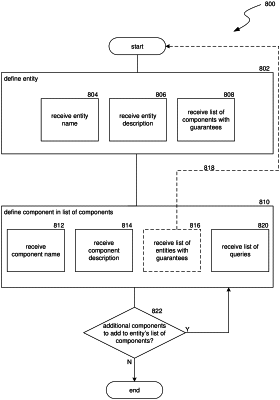| CPC G06T 19/00 (2013.01) | 20 Claims |

|
1. A method for device-agnostic representation of an artificial reality environment (XRE) using an XRE schema, the method comprising:
defining multiple features, in the artificial reality environment, each as an element defined by the XRE schema as either an entity or a component,
wherein the elements include at least one entity and each entity has a defined name, definition, and component list,
wherein the elements include at least one component and at least one component has a defined name, definition, entity list, and query list, and
wherein at least one element comprises one or more quantity guarantees with respect to its component list or entity list;
performing, for the elements defined by the XRE schema, application programming interface element constructor calls,
wherein constructed instances for the elements are returned in response to the element constructor calls, and
wherein at least one of the called element constructors that corresponds to the at least one element enforces the one or more quantity guarantees with respect to its component list or entity list; and
adding a node for each of the constructed instances of each element to a directed acyclic graph hierarchy for the artificial reality environment,
wherein the hierarchy has a pre-defined type of a root node that corresponds to an entity element,
wherein each edge in the hierarchy specifies a parent/child link between elements where the parent element contains the child element;
wherein the entity corresponding to the root node links to a physical boundaries component linked to one or more wall, floor, and/or ceiling entities; and
wherein the method is performed on a first type of artificial reality device and at least one of the elements is accessed by a second type of artificial reality device with a type different from the first type of artificial reality device.
|